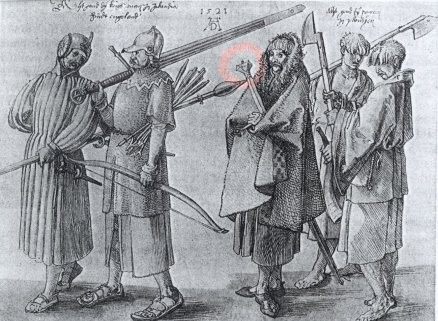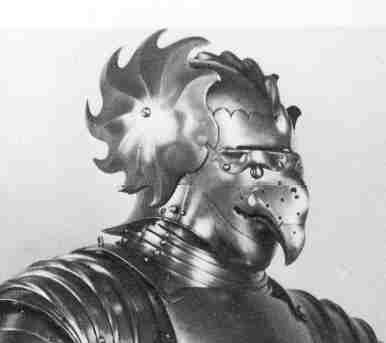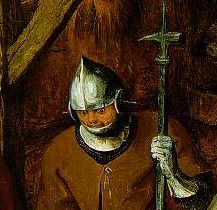| Author |
Message |
David McElrea

|
 Posted: Sat 05 Jun, 2004 6:29 am Post subject: Gallowglass sword identification? Posted: Sat 05 Jun, 2004 6:29 am Post subject: Gallowglass sword identification? |
 |
|
I have often wondered about one sword in particular in Durer's portrait of Irish mercenaries. I enclose the picture with the relevant weapon highlighted-- does anyone have any thoughts?
It seems to me that the guard may have quatrefoil terminals, (in common with many Scottish and Irish swords) but that is not clear on the pic I have. Also, there may be some slope to on the cross, but it appears to be quite straight to my eyes.
The pommel (which I have drawn particular attention to on the jpeg) is what caught my attention first. It isn't of a type that I am familiar with and doesn't seem to be very "Irish" in style.
So:
1) Does anyone know how such a pommel might be classified-- is it a variant of a 'V' pommel?
2) Is it likely an Irish sword (as per the cross) or a sword purchased/looted on the European mainland?
In asking this question I am assuming that Durer portrayed the arms carried accurately-- he did with the other weapons and clothing (as far as we know), so I have assumed this sword wasn't a whimsey thrown in.
Thanks in advance,
David
 Attachment: 48.46 KB Attachment: 48.46 KB

|
|
  |
 |
|
Jeremiah Swanger
|
 Posted: Sat 05 Jun, 2004 7:15 am Post subject: Re: Gallowglass sword identification? Posted: Sat 05 Jun, 2004 7:15 am Post subject: Re: Gallowglass sword identification? |
 |
|
| David McElrea wrote: | I have often wondered about one sword in particular in Durer's portrait of Irish mercenaries. I enclose the picture with the relevant weapon highlighted-- does anyone have any thoughts?
It seems to me that the guard may have quatrefoil terminals, (in common with many Scottish and Irish swords) but that is not clear on the pic I have. Also, there may be some slope to on the cross, but it appears to be quite straight to my eyes.
The pommel (which I have drawn particular attention to on the jpeg) is what caught my attention first. It isn't of a type that I am familiar with and doesn't seem to be very "Irish" in style.
So:
1) Does anyone know how such a pommel might be classified-- is it a variant of a 'V' pommel?
2) Is it likely an Irish sword (as per the cross) or a sword purchased/looted on the European mainland?
In asking this question I am assuming that Durer portrayed the arms carried accurately-- he did with the other weapons and clothing (as far as we know), so I have assumed this sword wasn't a whimsey thrown in.
Thanks in advance,
David |
I'm not entirely sure what you mean by the pommel not looking "Irish". The pommel is a ring with the tang bisecting it- about as Irish as a sword can possibly get. Museum replicas makes a "Gallowglass" sword with a ring pommel. Assuming that model is designed after that sword in Durer's portrait, the quillons actually end in tips that are shaped like a thistle.
You can also take a look at the Irish sword that Arms and Armor makes to get a better view of a ring pommel.
"Rhaegar fought nobly.
Rhaegar fought valiantly.
Rhaegar fought honorably.
And Rhaegar died."
- G.R.R. Martin's A Song of Ice and Fire
|
|
   |
 |
David McElrea

|
 Posted: Sat 05 Jun, 2004 8:37 am Post subject: Posted: Sat 05 Jun, 2004 8:37 am Post subject: |
 |
|
Hi Jeremiah,
Thanks for the reply. I am familiar with the standard Irish sword (commmonly referred to as a "ring-hilt"). Durer, De Heere, and others show this type as being almost universal amongst the Irish of the time.
The pommel I have highlighted is actually not an Irish "ring-hilt"-- the gallowglass on the left is holding the standard Irish weapon, but the kern(?) standing immediately to his right is holding the sword I was referring to (it is possible that the reddish colour I used is a bit too pale, but it has a coloured ring around the pommel).
It was that sword that peaked my curiosity.
David
|
|
  |
 |
|
Jeremiah Swanger
|
 Posted: Sat 05 Jun, 2004 9:04 am Post subject: Posted: Sat 05 Jun, 2004 9:04 am Post subject: |
 |
|
| David McElrea wrote: | Hi Jeremiah,
Thanks for the reply. I am familiar with the standard Irish sword (commmonly referred to as a "ring-hilt"). Durer, De Heere, and others show this type as being almost universal amongst the Irish of the time.
The pommel I have highlighted is actually not an Irish "ring-hilt"-- the gallowglass on the left is holding the standard Irish weapon, but the kern(?) standing immediately to his right is holding the sword I was referring to (it is possible that the reddish colour I used is a bit too pale, but it has a coloured ring around the pommel).
It was that sword that peaked my curiosity.
David |
Hi David,
I'm really sorry about that, I missed the fact that you highlighted it- I guess my focus went immediately to the biggest sword in the picture.
Yeah, the pommel you highlighted kinda looks vaguely like a type V, or "Fishtail" and I've never seen anything like that on an Irish sword.
Now I'm rather curious to hear what some more experienced folks have to say about it.
Again, I apologize for my previous post.
"Rhaegar fought nobly.
Rhaegar fought valiantly.
Rhaegar fought honorably.
And Rhaegar died."
- G.R.R. Martin's A Song of Ice and Fire
|
|
   |
 |
David McElrea

|
 Posted: Sat 05 Jun, 2004 10:46 am Post subject: Posted: Sat 05 Jun, 2004 10:46 am Post subject: |
 |
|
No problem, Jeremiah 
The only other idea I have come up with is a variant of the Type T pommels-- but am not sure. When I look at it I have the feeling that I have seen it somewhere, but it might just be a memory of having seen the picture a long time ago. It's quite an attractive sword, I think-- and the pommel, together with the Gaelic looking cross, suggests an interesting hybrid possibly.
David
|
|
  |
 |
David McElrea

|
 Posted: Sun 06 Jun, 2004 3:53 pm Post subject: Posted: Sun 06 Jun, 2004 3:53 pm Post subject: |
 |
|
Having looked at it again, a few more observations (and questions) come to mind.
I described it in the subject heading as a "Gallowglass sword", and then suggested that it was a kerne that was holding the sword in question. Having looked again, I suspect the two on the left are gallowglass, the two on the right are kerne, and the centre figure is an officer/chieftain. It's a guess, but his sword (again) is unique and looks to be of a different type than those often shown... but more on that in a moment.
Unlike the two kernes, his cloak seems to be of finer make (note the inside lining-- also the trim, which may be "shag" or possibly even fur). He also has footwear. While it is hard to make anything else out, it seems he could be a higher status warrior.
Now... the Irish sword on the left is a big two-hander-- if it fits within the typology Oakeshott has given us, would it be a Type XX? The sword mentioned earlier could be Type XXa (using the redefinition of that type given in "Records..."), but it is difficult to know for sure given the angle at which it is held. Any ideas?
Lastly, the gallowglass helms. I'm not very "up" on later medieval helms, but it looks like one may be a type of bascinet? Would it be a pig (or dog) faced bascinet? The other helm is like nothing am familiar with-- does nayone recognise it?
Sorry for pouring on the questions-- I just figured that if I could get an answer anywhere it would be here.
Thanks,
David
|
|
  |
 |
|
Felix Wang
|
 Posted: Tue 08 Jun, 2004 5:39 pm Post subject: Posted: Tue 08 Jun, 2004 5:39 pm Post subject: |
 |
|
The central gallowglass' helmet is a variant of a burgonet, I think. The neckguard is in lames, as far as I can tell, and is not as big as in some typical burgonets. On the other hand, the visor can be separate, but in this case is much bigger than usual. If you look at the Albion Mercenary's Tailor Casquetel, it vaguely resembles Durer's piece. Oakeshott's European Weapons and Armour shows somewhat similar burgonets.
I am working on the other helmet - but it is rather odd.
|
|
  |
 |
|
Allen W
|
 Posted: Wed 09 Jun, 2004 9:27 am Post subject: Posted: Wed 09 Jun, 2004 9:27 am Post subject: |
 |
|
|
The "other" helmet is similar to the pate defense that MRL carried a number of years ago and can be seen in artwork from or depicting the hundred years war.
|
|
  |
 |
David McElrea

|
 Posted: Wed 09 Jun, 2004 1:14 pm Post subject: Posted: Wed 09 Jun, 2004 1:14 pm Post subject: |
 |
|
Ah, thanks for that, Felix and Allen-- it would have been interesting to see MRL's item. Not the most attractive piece on paper, but it might have been more impressive in three dimensions.
Thanks again,
David
|
|
  |
 |
|
Felix Wang
|
 Posted: Wed 09 Jun, 2004 7:30 pm Post subject: Posted: Wed 09 Jun, 2004 7:30 pm Post subject: |
 |
|
It occurs to me that the second, "other" helmet may be only part of a helmet - i.e. missing a visor. The hook at the middle of the forehead looks pretty useless, except as a way for the helmet to get caught in something (for example, an enemy polearm). However, if there was a missing bit, the hook may have been part of a clasp or hinge. We know that may fighters preferred the better ventilation and peripheral vision that came with wearing a helmet with the visor up. This is reflected in the stories of men killed by being struck in the face, which are more common than men being killed through their breastplates and the like. Perhaps the visor was permanently removed.
The "rosette" things on the side of this helmet are also a bit strange. The nearest thing I can find to them, in a cursory search, are the elaborate hinges that some visors had (see attached). I know the picture is of parade / tournament armor, but the principle might be the same. (?)
 Attachment: 6.88 KB Attachment: 6.88 KB

|
|
  |
 |
|
Allen W
|
 Posted: Wed 09 Jun, 2004 7:50 pm Post subject: Posted: Wed 09 Jun, 2004 7:50 pm Post subject: |
 |
|
Felix I think the hook is a folding nasal as seen on klappvisors.
David I'm afraid the MRL version and the paintings I've seen are just as ugly as this one.
|
|
  |
 |
|
Felix Wang
|
 Posted: Wed 09 Jun, 2004 8:22 pm Post subject: Posted: Wed 09 Jun, 2004 8:22 pm Post subject: |
 |
|
A folding nasal! 
A very intriguing idea. I know of klappvisors where the plate comes down to cover the face, but I wasn't aware (or forgot?) that a nasal could be folded the same way. The sliding nasals of the Middle East, those I remember, but they have nothing to do with this case. Do you happen to have a reference (or picture to post?) for the folding nasal? Maybe a good image will stick better in my brain  . .
|
|
  |
 |
|
Allen W
|
 Posted: Thu 10 Jun, 2004 6:54 am Post subject: Posted: Thu 10 Jun, 2004 6:54 am Post subject: |
 |
|
|
I can't find an example right now but I'm thinking of those klappvisors with with very narrow visors exposing the eyes and cheeks before swelling slightly to conceal the mouth and chin.
|
|
  |
 |
|
Steve Fabert
|
 Posted: Thu 10 Jun, 2004 6:59 am Post subject: Posted: Thu 10 Jun, 2004 6:59 am Post subject: |
 |
|
| Allen W wrote: | | I can't find an example right now but I'm thinking of those klappvisors with with very narrow visors exposing the eyes and cheeks before swelling slightly to conceal the mouth and chin. |
You mean something like this one, or another design entirely?
http://varmouries.com/tran_05.html
|
|
  |
 |
|
Allan Senefelder
Industry Professional
|
 Posted: Thu 10 Jun, 2004 8:00 am Post subject: Posted: Thu 10 Jun, 2004 8:00 am Post subject: |
 |
|
Hey Steve . The helmet you've shown doesn't have a folding nasal . The plate piece that runs up the middle of the
face is actually attached to the maille below and is raised up end engaged on two turn pins on top to hold it in place .
The folding nasal on the helm in the woodcut up top is set in a small u-shaped bracket with a rivet passing through
either side of the braket and the nasal bar . The nasal bar has a slightly oval shape at its base that contacts the surface of the helmet when the bar is sticking straight out from the helm so the bar will effectively be locked into the up or down postion other wise unless mannually pushed to its other position . The other helmet is quite common in illustrations and
illuminations from the second half of the 15th century . Look closely at scenes depicting large groups of soldier participating in sieiges outside castle walls and you'll almost always find 4-6 guys wearing one . Not to many examples
survive but based on the illustrated material from the period it seems to have been a very common infantry helmet .
|
|
   |
 |
|
Allen W
|
 Posted: Thu 10 Jun, 2004 8:28 am Post subject: Posted: Thu 10 Jun, 2004 8:28 am Post subject: |
 |
|
|
Steve and Allan that was the style of helm I was thinking of. That the visor attached to the mail was my oversite. Thanks for clearing that up.
|
|
  |
 |
Sean Flynt

|
|
   |
 |
Sean Flynt

|
 Posted: Thu 10 Jun, 2004 10:25 am Post subject: Posted: Thu 10 Jun, 2004 10:25 am Post subject: |
 |
|
...and if you look at the French soldiers in the bottom right corner of this ca. 1475 illustration from Froissart's Chronicles, you'll see some possible examples of the mystery helm. Can't tell if these have the folding nasal, but those "Princess Leia" ear pieces are common in the Froissart illustrations.
http://www.bnf.fr/enluminures/images/jpeg/i3_0020.jpg
With the Dürer image post-dating this one by only about 50 years, it's certainly possible that some version of the type was still in use in Ireland.
I'll resist the temptation to say something Bond-ian like "I guess this fellow's met his end"....
 Attachment: 19.62 KB Attachment: 19.62 KB

|
|
   |
 |
David McElrea

|
 Posted: Fri 11 Jun, 2004 2:08 pm Post subject: Posted: Fri 11 Jun, 2004 2:08 pm Post subject: |
 |
|
Hi again everyone,
Thanks for all of the info.
Allen W wrote: | Quote: | | David I'm afraid the MRL version and the paintings I've seen are just as ugly as this one. |
LOL-- Ah well, I guess aesthetics wasn't foremost in the minds of every soldier... or perhaps this is a case of beauty being in the eye of the beholder. I don't know.
Sean, thanks for the pic of Dublin's civic sword-- it hadn't been mentioned. I think the sword I mentioned in the beginning is faceted like the sword you've posted, but my eyes interpreted the facets as being concave-- possibly hollow ground? Also, the pommel looks as though, if one viewed it from above it would have an irregular shape rather than a "straight" (?!?) circle... see below for a rough idea.
Edit: I had posted a digitally altered pic to try and visualise what I thought the pommel might look like, but after looking again, I realised it didn't work... This sketch done in paint might do more justice, but I suspect it would look better if I had paid more attention in geometry when I was in school 
I'd be interested to know if it looks like a reasonable representation of the shape. (The reason why I'm bothering, by the way, is that I really like this sword-- some day in the far future I may even think about getting a custom job done if I can figure it out).
Cheers,
David
 Attachment: 6.88 KB Attachment: 6.88 KB

|
|
  |
 |
|
Scott Bubar
Location: New England Joined: 21 Aug 2003
Posts: 120
|
 Posted: Sat 12 Jun, 2004 7:38 pm Post subject: More ear muffs Posted: Sat 12 Jun, 2004 7:38 pm Post subject: More ear muffs |
 |
|
Detail of Pieter Bruegel the Elder's The Adoration of the Kings from Web Gallery of Art:
 Attachment: 14.99 KB Attachment: 14.99 KB

|
|
  |
 |
|
|

